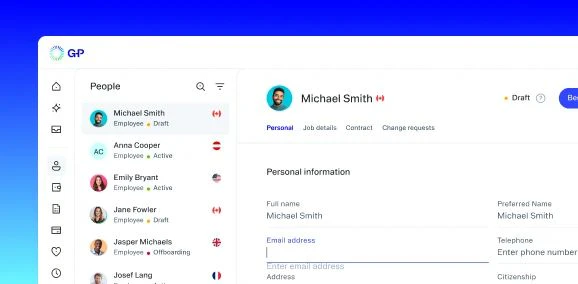Un esquema competitivo de beneficios para empleados puede ayudar a respaldar los objetivos generales de crecimiento de su empresa en Ecuador. Con la estrategia correcta, puede crear un enfoque que se adapte a las necesidades únicas de su empresa y ofrezca un valor óptimo para su equipo. Los factores clave a considerar incluyen el cumplimiento, los impuestos, las expectativas de los empleados y los estándares del mercado local.
Planes de beneficios para empleados de Ecuador
A medida que establezca su negocio internacionalmente, deberá desarrollar un plan de beneficios que cumpla con las regulaciones legales y los estándares del mercado. Aunque el gobierno de Ecuador describe los beneficios obligatorios para los empleados, la mayoría de los empleadores también ofrecen beneficios complementarios para atraer y retener talentos. Algunas de las prestaciones complementarias más comunes incluyen las siguientes:
- Bonos de vacaciones
- Oportunidades de teletrabajo
- Estipendios para transporte
- Asignación de teletrabajo
- Asignación telefónica
- Asignación del seguro
Beneficios requeridos en Ecuador
De acuerdo con las leyes laborales nacionales, las empresas de Ecuador deben proporcionar los siguientes beneficios obligatorios como mínimo:
- 13th remuneración: también conocida como bono de Navidad, los trabajadores tienen derecho a recibir un pago proporcional mensual de 1/12 de la remuneración que reciben durante el año calendario.
- 14th remuneración: también conocida como bonificación escolar, los trabajadores tienen derecho a recibir una bonificación mensual equivalente a 1/12 del salario básico unificado para los trabajadores en general (actualmente 450 USD).
- Fondo de reserva: Después de 1 año de servicio, los empleados tienen derecho a una suma equivalente a 1 mes de salario que los empleadores deben pagar durante cada año de servicio a partir de entonces.
- Participación en las ganancias: los empleadores deben distribuir el 15 % de las ganancias netas del año a los empleados. El monto es deducible para el cálculo del impuesto sobre la renta.
- Seguro social: los empleadores deben inscribir a los empleados en el IESS. Los empleadores contribuyen el 12.15 % y los empleados el 9.45 % de la remuneración mensual.
- Jubilación del empleador: un empleado que completa 25 años de servicio con el mismo empleador (a menos que se reconozca la antigüedad) tiene derecho a una pensión de jubilación de por vida, también pagadera a sus herederos durante un máximo de 1 año después de su fallecimiento. El trabajador también tiene derecho a una pensión de jubilación proporcional del empleador, cuando ha sido despedido sin causa después de 20 años de servicio con el mismo empleador (a menos que se reconozca la antigüedad). Ambas partes pueden acordar proporcionar un fondo de jubilación, que reemplaza la pensión de jubilación mensual.
- Pago global de fondos: este es un pago único realizado por el empleador al empleado después de la finalización del contrato de empleo (por acuerdo entre las partes). En general, implica proyectar las pensiones mensuales que recibiría un jubilado, teniendo en cuenta factores como la expectativa de vida, el valor actual del dinero, entre otros.
Diseño de planes de beneficios para empleados de Ecuador
Si bien un programa de beneficios competitivo y que cumple con los requisitos se verá diferente de un país a otro, puede seguir estos pasos básicos para crear un plan exitoso en cualquier lugar.
1. Establezca su presupuesto y prioridades.
Evalúe los ingresos proyectados de su empresa y decida cuánto puede permitirse destinar a las disposiciones de los empleados. Querrá determinar las principales metas para la región, por ejemplo, las tasas de retención de empleados y el crecimiento del equipo, y decidir cómo apoyar esos objetivos con sus ofertas de beneficios.
2. Explore el mercado local.
Antes de interactuar con el mercado local, tómese el tiempo para investigar las tendencias y condiciones económicas. Es aconsejable investigar lo que otras empresas del área ofrecen en sus planes de beneficios. Vea si su empresa puede igualar o superar esas disposiciones.
Para comprender mejor lo que los trabajadores quieren de los empleadores, hable directamente con los empleados locales y analice sus necesidades y preferencias de beneficios.
3. Comience a diseñar su programa.
Comience a crear un plan de beneficios que se adapte a las condiciones del mercado local y satisfaga las necesidades de los empleados. Comience con las disposiciones obligatorias y use el resto de su presupuesto para los beneficios adicionales de máxima prioridad.
Cuando calcule los costos finales, recuerde contabilizar las contribuciones de los empleados y cualquier gasto administrativo.
Costo promedio de los beneficios
Muchos factores pueden afectar los gastos del programa de beneficios de una empresa, por lo que un costo promedio podría no ser una métrica valiosa. En cambio, concéntrese en el presupuesto y los requisitos de su empresa para diseñar un programa sostenible.
Puede considerar designar un porcentaje de los ingresos totales para apoyar su programa cada año. Con este enfoque, podrá escalar sus fondos a medida que su empresa crezca.
Cómo calcular los beneficios de los empleados
Siga los requisitos legales para los pagos y estándares de beneficios obligatorios. Asegúrese de que su empresa pueda cumplir o superar esas estipulaciones. Los empleadores están obligados a proporcionar una licencia anual y una licencia por feriado con goce de sueldo completo. Algunos beneficios, como un fondo de ahorros, son obligatorios una vez que se establecen en las políticas de la compañía.
Cuando desarrolle disposiciones de beneficios adicionales, aproveche su investigación para establecer tasas competitivas en el mercado local. Las tarifas de los beneficios, como los beneficios de transporte, vivienda o uso variable, dependerán de la industria y de las necesidades específicas de los empleados.
¿Cómo se gravan los beneficios de los empleados en Ecuador?
Todos los ingresos que no se consideren gastos personales están sujetos a impuestos. Puede esperar incluir cualquier beneficio monetario como parte de los cálculos de ingresos totales de los empleados.
Beneficios de salud para empleados
El seguro médico patrocinado por el estado es obligatorio para todos los empleados en Ecuador.
Asóciese con G-P para desarrollar su fuerza laboral en todos lados.
Como su socio en la expansión global, G-P se encargará de la nómina y el cumplimiento, para que pueda concentrarse en hacer crecer su equipo y escalar su negocio. Nuestra Global Employment Platform global líder en el mercado está impulsada por el primer conjunto de productos de empleo globales totalmente personalizables y respaldada por el grupo más grande del sector de expertos legales y de RR. HH. nacionales para agilizar la gestión de nóminas y ayudarlo a ofrecer prestaciones locales competitivas y que cumplan con las normas.
Obtenga más información sobre nuestra plataforma y solicite una propuesta hoy mismo.

















